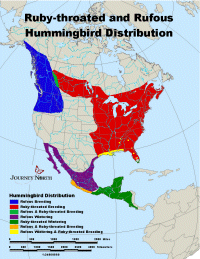Hummingbird
Migration Update: February 9, 2006
Today's Report Includes:
- Welcome to Journey North's Spring Hummingbird Migration Season
- Challenge Question #1: Why Come Back?
- The Migrations are About to Begin
- Getting Ready for Hummingbird Migration
- Making Sense of Journey North Maps
- NEW! Your Official Journey North Hummingbird Migration Journals
- The Story Behind the Picture
- Hummers: "It’s All About ME!"
 |
Photo Carl A. Pascoe |
The migrations are about to begin, and we're glad you're here! With your help, Journey North is tracking the return of both Rufous hummingbirds and Ruby-throated hummingbirds. Most of the hummers are on their wintering grounds right this minute—enjoying sunny skies, toasty temps, and plenty of food. These birds are so light that you could put 10 of them in an envelope and mail the letter with a single stamp. But they'll return on their own power, flapping their wings 60-80 beats each second. Most will cover hundreds of miles, and many Ruby-throated hummingbirds will fly nonstop across the Gulf of Mexico. How do they do it? How long does it take? When will they come? We'll soon find out. But first, you may wonder WHY they bother to come back at all! A closer look at landmass offers a clue. Investigate here:
Challenge Question #1: Why Come Back?
Challenge Question #1:
"If things are so great on the wintering grounds, why do these tiny birds make the long, hard journey north?"To respond to this question, please follow these instructions.
The Migrations are About to Begin
As you see on these maps, the very first reports of rufous and ruby-throated hummingbirds have arrived. We hope you'll enjoy tracking the migrations with us this spring!
 Distribution Map |
||
| Rufous
Most
data courtesy of Mike Patterson, |
Ruby-throated
Most
data courtesy of Lanny Chambers, |
Getting Ready for Hummingbird Migration
Where are the hummingbirds coming from? Where are they going? We suggest the process of making a map to start the season. It will orient you to the geography of these migrations and provide the best context to follow news in the upcoming Migration Updates. See how to lay the groundwork, use the student handouts, and make up your own fun geography quizzers. Everything is here:
You'll also want to be sure you can tell a rufous from a rubythroat. Start here, and keep going:
Making Sense of Journey North Maps
Take a look at today's migration maps and prepare to watch the changes ahead. You will see a progression of real-time maps in each Migration Update this spring. Then the detective work begins! We will include basic questions to help you analyze migration patterns. Each time you look at a new map—starting with today's—you can consider some basic questions like these:
NEW! Your Official Journey North Hummingbird Migration Journals
Keep track of migration news, answers to Challenge Questions, fun facts and your own questions with an official journal. Click below for the print-and-go cover and pages, plus tips for using them.
Keep a Journal This journal is designed to be used throughout the hummingbird spring migration, starting today. |
 |
 |
 |
Thanks,
Heather Ray!
|
The
Story Behind the Picture
Here's the true story about the hummingbird
on your Journal cover photo:
During the first week of September, hundreds of migrant birds were colliding with three glass office towers in Toronto, Canada. All of the birds saw the reflection of trees in the mirrored glass. Those reflections looked just like the real thing, so the birds kept flying and crashed into the glass. Heather Ray was among the many dedicated people of FLAP who patrol the areas around reflective buildings. She’d already picked up over a dozen dead birds--all hummingbirds. Hoping to find at least one still alive, Heather decided to walk around the building one more time. As she rounded the corner, Heather saw on the pavement a bright smudge that hadn’t been there 10 minutes ago. It was another hummingbird, lying on her side and likely dead. But as Heather gently wrapped her hand around the tiny body, she felt the slightest vibration. The hummingbird was still alive! Following the correct steps for such rescues, Heather made a donut-shaped nest inside a small paper bag to keep the bird upright. She then gave the bird sugar water every 15 minutes. Amazingly, the bird quickly regained her strength. Later that day, as Heather prepared to release the tiny jewel, her son came outdoors and snapped the picture. Thanks to FLAP and Heather for saving this tiny bird's life, and for sharing this special photo with all of us.
|
FLAP is an organization in Toronto, Canada that helps safeguard migratory birds in cities. FLAP stands for Fatal Light Awareness Program. FLAP has worked since 1993 to address the issue of bird collisions with structures—the leading cause of death to migratory birds. This April, in time for spring migration, the "Lights Out Toronto" program will teach Toronto citizens how to prevent the deaths of thousands of migratory birds by simple acts like turning lights off. Hooray for Toronto for being a leader! Visit FLAP on the Web and see what you can do to save birds where YOU live! |
 |
 |
Rufous
hummingbird female
Photo Laura Erickson |
Hummers:
"It’s All About ME!"
If hummingbirds were as big as ravens, it probably wouldn't be safe to
go for a walk in the woods! As you wait for these fierce little aerobats
to return this spring, learn more about them.
How fast do they fly? How long do they live? How much do they eat? You'll
be amazed!
The Next Hummingbird Migration Update Will Be Posted on February 23, 2006.
Copyright
1997- 2006 Journey North. All Rights Reserved.
Please send all questions, comments, and suggestions to our
feedback form.
![]()
![]()
![]()
![]()
![]()
![]()









